Links open in new pages
Magic: The Gathering is a great game with a troubling digital history. In one sense, it's really sad, because Hearthstone is immeasurably polished - a thing that Blizzard is absurdly good at. And where Blizzard have gone, others have attempted to follow, because surely, if they can make it work to the tune of a silly number of people throwing money at imaginary cards that they're never going to really own [because the servers will go down and then you'll be left with nothing] then someone else has to be able to share the pot, right?
Probably. But a lot of that is going to depend on lots of little factors. And where Spellweaver comes up strong in some of those factors, it's just kind of bland and uninteresting for a lot of the rest.
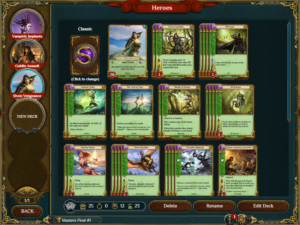
Let's start at the very beginning. [a very good place to start!]
Spellweaver works the same way most of these [new] games work: you have a hero. The hero has a life total and a hero power. You build your deck based on the colour of your hero. If your hero is green, you're naturally going to play mostly green cards. You can swing into an extra colour [but a third becomes problematic - I'll get into that in a moment.]
Cards are the usual suspects: You have creatures, spells, artifacts and enchantments. Spells are generally one-time effects, while creatures, artifacts and some enchantments stick around until they die.
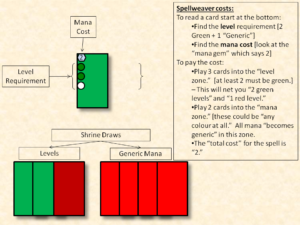
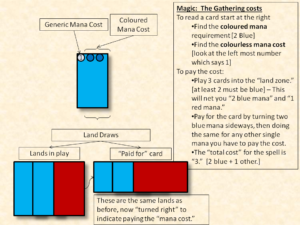
Oh. And in a curious throwbacky twist, this game has lands. Yes. Really. And lands have the same problem they do in Magic: don't draw enough? Great, you're mana screwed. And to talk about Mana screw, I actually have to discuss casting cost. And here's one of the more interesting parts of the game [that also leads to one of it's greatest downfalls.]
In Magic, there's the concept of "converted mana cost." You take the number of total mana symbols on the card - coloured and otherwise - and you add them together. The way you read a magic card is: "this card costs two green" - and you have to pay that two green with specifically green sources like lands that can only produce green mana - "and six others." If you control a smattering of green, red and white lands, you can pay the rest of the mana with that land. So, the converted mana cost is "eight in total."
In Spellweaver, it looks like there's a converted mana cost, because costs are always written as "two red symbols and three generic mana symbols" but this is the first real problem with the game. You never count those coloured symbols as part of the cost. Instead, they're the "level" of your investment in that colour. The cost of a card is literally always just the gem stone in the upper left hand corner. But you must meet it's level requirement in order to cast it.
For people coming from Magic, this is very weird. And it takes a while to get used to. It also has a design consequence: playing multi-colour in Spellweaver is very difficult unless you're just splashing other colours.
Because the game set up literally requires you to pay shrines to up your level in the requisite colour, it means that - especially at the beginning of the game - things start off really slowly while you dither around with "should I add a level in my colour? Should I make more generic mana?"
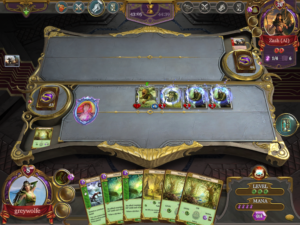
And this is where the downfall of Spellweaver happens: that dithering? The players have decided it's not worth it. A lot of the PVP boils down to who can get going the fastest, because there aren't really any good ways to deal with a legion of guys. So the design intent of Spellweaver - which was to make colour matter - has forced another subtheme into the game. Speed matters. Because there's so few ways to deal with a horde, everyone plays the horde. And not just "the horde," but "the powered horde," because they've been in the game for long enough that they own every card in existence.
This creates a new player problem, which - in turn - is going to kill the game: players will try the game, discover there's PVP, discover that the starter decks get you trounced in a matter of minutes if you play with them, and leave. Because...
...getting cards is super difficult. In Hearthstone, you can buy a pack of cards almost every second day, but in that particular game, the cards you get for free are actually reasonable and matter to the long-term health of the game. Everyone has access to fireball in mage. Everyone has access to Hex in shaman. In Spellweaver, you have to pick your starter. And some of the starters leave...a lot to be desired.
There's also the speed with which you obtain cards. In Spellweaver, because it's impossible to win in PVP when you're just starting out [it seems like there's no real match-making], you will simply never be able to unlock all of the quests for a given region. Nor will you be able to reap the fruits of playing in PVP [which gives better payouts] - you are stuck playing the incredibly grindy AI. Incredibly grindy gives slow XP [and XP is how you unlock new starters - one every five levels] - and low money payouts. And this, too, is going to drive people away long term.
That and the tutorial. Good Lord, that tutorial. It barely covers the game's bases. It doesn't bother teaching deck construction rules. It attempts to teach how speed works, but then leaves you somewhat in the dark. [Speed is a measure of how fast a creature "goes." Really fast creatures can attack everything. Really slow creatures can only attack the creatures with their speed or lower.] - it never properly explains flying. [If you're from Magic, it's not the same.] The casting cost dilemma is brought up, but never properly covered. The tutorial needs work. I don't like the new digital incarnation of Magic: The Gathering, but it's tutorial is [more-or-less] superb. Spellweaver can learn from that.
Other than all this, the game is a pretty bland Magic clone. Land problems and all. It's not a bad game - the art is fantastic - but it's going to drown in a sea of other me-too games, because it's not doing enough to differentiate itself. There is also the matter of the PVP being newbie-hostile. These twin things, I think, are going to make Spellweaver die a slow and - sadly lingering death. Which is too bad, in one sense. The art direction for the cards is rather good and my hope is that the creators are taking this kind of feedback on board and bettering the game, but this betterment is going to have to happen quickly. The digital card game boom is very nearly basically over, thanks to Hearthstone.
Final verdict? Play, but don't touch the PVP unless you dump a ton of money or time into the game. It'll just make you feel bad.
I did a kind of "new player's guide to Spellweaver" and you can see that here.

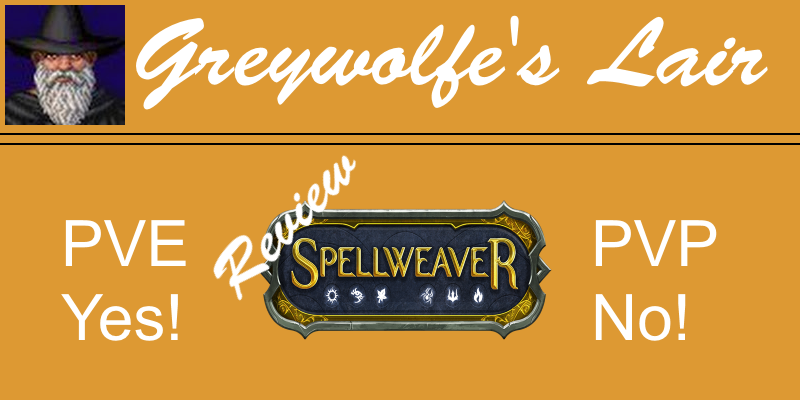
Is this serious? Spellweaver being more expensive than Hearthstone?!